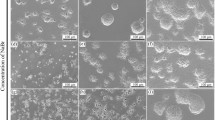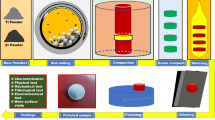Abstract
Ti50Ni50 and Ti50Ni49.5Mo0.5 shape memory alloys and Ti30Nb1Fe1Hf alloy with a low elastic modulus were prepared for biomedical implant applications. Effects of the composition of the TiNi/TiNb-based alloys and electrical discharge machining (EDM) parameters on the properties of the materials were investigated. The addition of Mo to TiNi or of Nb to Ti clearly reduced the material removal rate (MRR), electrode wear rate, surface roughness, and recast layer thickness, which was attributed to the increased melting temperature and thermal conductivity of the materials. The surface roughness (Ra) of the electrical discharge machined (EDMed) alloys obeyed the empirical equation Ra = β(I p × τ p )α. A higher discharge current I p combined with an appropriate pulse duration τ p can achieve the highest MRR and lowest thickness of the recast layer. However, under low current and a small pulse duration, the recast layer has a surface roughness of 1 μm, which is favorable for oral implants. In addition, the EDMed surface contains Ti and Nb oxides, which are well-known biocompatible materials.
Similar content being viewed by others
Reference
Sul YT, Johansson C, Wennerberg A, Cho LR, Chang BS, Albrektsson T (2005) Optimum surface properties of oxidized implants for reinforcement of osseointegration: surface chemistry, oxide thickness, porosity, roughness, and crystal structure. Int J Oral Maxillofac Implants 20:349–359
Cui ZD, Man HC, Yang XJ (2005) The corrosion and nickel release behavior of laser surface-melted NiTi shape memory alloy in Hanks’ solution. Surf Coat Technol 192:347–353
Ou SF, Chou HH, Lin CS, Shih CJ, Ou KL, Pan YN (2012) Effects of anodic oxidation and hydrothermal treatment on surface characteristics and biocompatibility of Ti–30Nb–1Fe–1Hf alloy. Appl Surf Sci 258:6190–6198
Thian ES, Huang J, Barber ZH, Best SM, Bonfield W (2011) Surface modification of magnetron-sputtered hydroxyapatite thin films via silicon substitution for orthopaedic and dental applications. Surf Coat Technol 205:3472–3477
Kim H, Choi SH, Ryu JJ, Koh SY, Park JH, Lee IS (2008) The biocompatibility of SLA-treated titanium implants. Biomed Mater 3:025011–025017
Geesink RG, Hoefnagels NH (1995) Six-year results of hydroxyapatite-coated total hip replacement. J Bone Joint Surg-Br 77:534–547
Chen SL, Yan BH, Huang FY (1999) Influence of kerosene and distilled water as dielectrics on the electric discharge machining characteristics of Ti–6A1–4V. J Mater Process Tech 87:107–111
Kumar A, Kumar V, Kumar J (2013) Multi-response optimization of process parameters based on response surface methodology for pure titanium using WEDM process. Int J Adv Manuf Technol 68:2645–2668
Pradhan BB, Masanta M, Sarkar BR, Bhattacharyya B (2009) Investigation of electro-discharge micro-machining of titanium super alloy. Int J Adv Manuf Technol 41:1094–1106
Azad MS, Puri AB (2012) Simultaneous optimisation of multiple performance characteristics in micro-EDM drilling of titanium alloy. Int J Adv Manuf Technol 61:1231–1239
Moses MD, Jahan MP (2015) Micro-EDM machinability of difficult-to-cut Ti-6Al-4V against soft brass. Int J Adv Manuf Technol 81:1345–1361
Wang XZ, Liu ZD, Xue RY, Tian ZJ, Huang YH (2014) Research on the influence of dielectric characteristics on the EDM of titanium alloy. Int J Adv Manuf Technol 72:979–987
Sumner DR, Galante JO (1992) Determinants of stress shielding: design versus materials versus interface. Clin Orthop Relat Res 274:202–212
Kuroda D, Niinomi M, Morinaga M, Kato Y, Yashiro T (1998) Design and mechanical properties of new β type titanium alloys for implant materials. Mater Sci Eng A 243:244–249
Kumar PK, Lagoudas DC (2008) Introduction to shape memory alloys. Springer, New York
Mckay GC, Macnir R, MacDonald C, Grant MH (1996) Interactions of orthopaedic metals with an immortalized rat osteoblast cell line. Biomaterials 17:1339–1344
Sarmiento-Gonzalez A, Encinar J, Marchante-Gayon JM, Sanz-Medel A (2009) Titanium levels in the organs and blood of rats with a titanium implant, in the absence of wear, as determined by double-focusing ICP-MS. Anal Bioanal Chem 393:335–344
Albrektsson T, Wennerberg A (2005) The impact of oral implants - past and future, 1966–2042. J Can Dent Assoc 71(5):327
Zhao JM, Tsuru K, Hayakawa S, Osaka A (2008) Modification of Ti implant surface for cell proliferation and cell alignment. J Biomed Mater Res A 84A:988–993
Lin HC, Wu SK (1992) Strengthening effect on shape recovery characteristic of the equiatomic TiNi alloy. Scripta Metall Mater 26:59–62
Colling EW (1984) The physical metallurgy of titanium alloys. American Society for Metals, Metals Park
Unu Y, Endo O, Nakajima T (1991) Fundamental aspect of the crater generation mechanism by a single pulse discharge. J Jpn Soc Elect Mach Eng 25:9–22
Gadalla AM, Bozkurt B (1992) Expanding heat source model for thermal spelling of TiB2 in electrical discharge machining. J Mater Res 7:2853–2858
Hsieh SF, Hsue WJ, Chen SL, Lin MH, Ou KL, Mao PL (2013) EDM surface characteristics and shape recovery ability of Ti35.5Ni48.5Zr16 and Ni60Al24.5Fe15.5 ternary shape memory alloys. J Alloy Compd 571:63–68
Patel MR, Barrufet MA, Eubank PT, Dibitonto DD (1989) Theoretical models of the electrical discharge machining process. Part I: a simple anode erosion model. J Appl Phys 66:4104–4141
Rebelo JC, Dias AM, Kermer D, Lebrun JL (1998) Influence of EDM pulse energy on the surface integrity of martensitic steels. J Mater Process Technol 84:90–96
Jeswani ML (1978) Roughness and Wear Characteristics of Spark-Eroded Surfaces. Wear 51:227–236
Wennerberg DDS, 1996. On Surface Roughness and Implant Incorporation. Thesis defended 19.4.1996. Ext. examin.: Professor P.-O. Glantz.
Rosa AL, Márcio MB (2003) Effect of cpTi surface roughness on human bone marrow cell attachment, proliferation, and differentiation. Braz Dent J 14(1):16–21
Hasçalık A, Çaydaş U (2007) Electrical discharge machining of titanium alloy (Ti–6Al–4V). Appl Surf Sci 253:9007–9016
Gu YW, Tay BY, Lim CS, Yong MS (2005) Biomimetic deposition of apatite coating on surface-modified NiTi alloy. Biomaterials 26:6916–6923
Wicks CE, Block FE (1963) Thermodynamic properties of 65 elements-their oxides halides carbides and nitrides. Bureau of Mines. United States Government Printing Office, Washington
Huang TS, Hsieh SF, Chen SL, Lin MH, Ou SF, Chang WT (2015) Surface modification of TiNi-based shape memory alloys by dry electrical discharge machining. J Mater Process Tech 221:279–284
Author information
Authors and Affiliations
Corresponding author
Rights and permissions
About this article
Cite this article
Hsieh, SF., Lin, MH., Chen, SL. et al. Surface modification and machining of TiNi/TiNb-based alloys by electrical discharge machining. Int J Adv Manuf Technol 86, 1475–1485 (2016). https://doi.org/10.1007/s00170-015-8257-x
Received:
Accepted:
Published:
Issue Date:
DOI: https://doi.org/10.1007/s00170-015-8257-x




